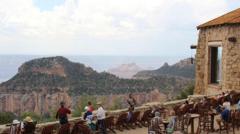Is the Loss of Grand Canyon Lodge Breaking Hearts for Locals and Visitors?

The Heartbreaking Loss of the Grand Canyon Lodge: A Community Mourns
The Grand Canyon is not just a natural wonder; it is a sacred space rich with history and emotional resonance for countless visitors and locals. Recently, tragedy struck this iconic location when wildfires led to the destruction of the Grand Canyon Lodge. This article delves into the significance of the lodge, the impact of the fire, and the community's hopes for its future, all while highlighting the beauty and importance of preserving such historical sites.
The Grand Canyon Lodge: A Historical Treasure
The Grand Canyon Lodge, perched at an impressive elevation of 8,000 feet (2,438 meters) on the North Rim, has long been a cherished destination for honeymooners, hikers, and nature enthusiasts alike. Established in 1928 by architect Gilbert Stanley Underwood, the lodge was designed to complement the stunning vistas surrounding it. The structure was built using local stone and timber, creating a natural harmony with its environment.
For many, the lodge served not just as a place to stay, but as a refuge for the soul. Visitors often described it as "stunning" and a "balm for the weary." With its panoramic views, the lodge offered a unique vantage point to marvel at the breathtaking landscapes of the Grand Canyon.
The Wildfire: A Sudden Catastrophe
On July 4, a lightning strike ignited what would become the Dragon Bravo Fire. Initially, park officials believed the blaze would be containable. However, as winds picked up and conditions worsened, the fire quickly escalated, leading to extensive evacuations and firefighting efforts.
Firefighters were deployed to protect the lodge, but their efforts were complicated when a water treatment plant caught fire, releasing toxic chlorine gas into the atmosphere. This forced an evacuation, leaving the historic lodge vulnerable to the advancing flames.
The Community's Reaction
The news of the Grand Canyon Lodge's destruction sent shockwaves through the community. Mr. Davy Crockett, vice-president of the Grand Canyon Historical Society, expressed his heartbreak, stating, "It broke my heart. I was devastated." His sentiments echoed across social media platforms, where hundreds of tributes poured in, memorializing the beloved lodge.
Tour guides, locals, and visitors alike mourned the loss of a place many considered an old friend. Karne Snickers, a tour guide with 24 years of experience on the North Rim, described the lodge as a "spiritual" place where visitors often left with tears in their eyes, reluctant to part from the beauty it offered.
Nature's Loss: Beyond the Lodge
The destruction of the Grand Canyon Lodge was not just a loss of a building; it signified a broader ecological tragedy. The fire claimed not only the lodge but also vast stretches of surrounding nature, including ancient ponderosa pines that had stood for 400 years.
Ms. Snickers lamented the loss of a particularly large tree that she often encouraged hikers to embrace during tours. "Much of the beauty is gone," Mr. Crockett noted, emphasizing that it would take decades for the ecosystem to recover.
A Historical Perspective: The Lodge's Resilience
This was not the first time the Grand Canyon Lodge faced destruction. The original structure opened in 1928 but was lost to fire just four years later due to an incident in the kitchen. The subsequent construction of a new lodge during the Great Depression was fraught with challenges, including a massive snowstorm that isolated workers for weeks. Despite these adversities, the lodge reopened in 1938, becoming a cherished summer getaway.
The Future of the Grand Canyon Lodge
As the ashes settle, the question remains: will the Grand Canyon Lodge be rebuilt? Park officials have yet to announce plans for reconstruction, but the hope among locals and visitors is palpable. "We have to rebuild this place," Ms. Snickers stated emphatically. "It's going to take time, but it needs to come back. It was a part of history." Many believe that reconstructing the lodge is not just about restoring a building, but about preserving a piece of cultural heritage and community identity.
Why Historical Sites Matter
The Grand Canyon Lodge is more than just a structure; it represents human resilience, community, and the intrinsic connection between people and nature. Historical sites like this lodge serve as reminders of our shared past, offering a sense of continuity and belonging. They are places where stories are shared, memories are made, and nature is celebrated.
As we reflect on the loss of the Grand Canyon Lodge, it is essential to consider the broader implications of such disasters. The preservation of historical sites is crucial, not only for their aesthetic and cultural value but also for their role in education and community cohesion. These places foster a sense of identity, drawing people together and inspiring future generations to appreciate and protect their heritage.
Key Takeaways
- The Grand Canyon Lodge was a historical treasure and a beloved destination for many.
- The recent wildfire devastated both the lodge and the surrounding natural environment.
- Local residents and visitors express a strong desire to see the lodge rebuilt, emphasizing its historical significance.
- The loss of such historical sites serves as a reminder of the importance of preservation and community identity.
FAQs About the Grand Canyon Lodge Fire
What caused the fire that destroyed the Grand Canyon Lodge?
The fire was ignited by a lightning strike on July 4, which initially appeared containable. However, changing weather conditions led to the fire's rapid escalation.
Will the Grand Canyon Lodge be rebuilt?
As of now, park officials have not announced any plans for rebuilding the lodge. However, many locals and visitors are hopeful for its reconstruction, recognizing its historical significance.
What impact did the fire have on the surrounding environment?
The fire not only destroyed the Grand Canyon Lodge but also affected large areas of surrounding nature, including ancient trees and wildlife habitats. Recovery of the ecosystem may take decades.
Why are historical sites like the Grand Canyon Lodge important?
Historical sites serve as cultural landmarks, offering a sense of identity and continuity for communities. They provide educational value and foster appreciation for history and nature.
In closing, the destruction of the Grand Canyon Lodge has left a profound impact on both the local community and visitors who held it dear. As we navigate this loss, it is essential to advocate for the preservation of our historical treasures and reflect on their significance in our lives. Will the Grand Canyon Lodge rise from the ashes, becoming a testament to resilience and hope? Only time will tell.
#GrandCanyonLodge #WildfireImpact #HistoricalPreservation
Published: 2025-07-14 19:13:07 | Category: wales


